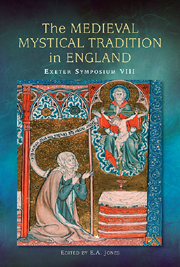 The Medieval Mystical Tradition in England
The Medieval Mystical Tradition in England Published online by Cambridge University Press: 05 July 2013
For all its unpacey ponderousness, when Chaucer's Boece renders passages of De consolatione philosophiae dealing with the ascent of the soul towards divine light and the transcendent Good, it reveals a delicate theological intelligence consonant with the devotional temper of contemporary mainstream piety. The maker of the Boke of Coumfort, an early-fifteenth-century Middle English prose version of book I of De consolatione drawing on Chaucer, was likewise willing to turn the Latin text to a more devotional end than was the case in the original. Nowhere is the pious recharging of the source more decisively advertised in both these vernacular versions than in their re-presenting, at the very outset of the work, of Lady Philosophy herself. In the original we read that on the hem of her gown are embroidered two symbolic Greek letters: ‘Π Grecum, in suppremo margine Θ’ (‘a Greek pi, and in the top border a theta’). These uncontroversially stand for Practica and Theoretica – practical and theoretical (that is, speculative) philosophy. But when Chaucer gets to this passage he puts a radically different interpretation on those sartorial letters. Following Jean de Meun's Livres de confort de philosophie, he glosses the Greek letters not just with their counterparts from the Latin alphabet, but also with a telling expositio sententie that equates them with the active and contemplative lives respectively:
In the nethereste hem or bordure of thise clothes, men redden ywoven in a Grekyssh ‘P’, that syngnifieth the lyf actyf; and aboven that lettre in the heyeste bordure a Grekyssh ‘T’, that singnifieth the lyf contemplatyf.
(lines 16-19)To save this book to your Kindle, first ensure [email protected] is added to your Approved Personal Document E-mail List under your Personal Document Settings on the Manage Your Content and Devices page of your Amazon account. Then enter the ‘name’ part of your Kindle email address below. Find out more about saving to your Kindle.
Note you can select to save to either the @free.kindle.com or @kindle.com variations. ‘@free.kindle.com’ emails are free but can only be saved to your device when it is connected to wi-fi. ‘@kindle.com’ emails can be delivered even when you are not connected to wi-fi, but note that service fees apply.
Find out more about the Kindle Personal Document Service.
To save content items to your account, please confirm that you agree to abide by our usage policies. If this is the first time you use this feature, you will be asked to authorise Cambridge Core to connect with your account. Find out more about saving content to Dropbox.
To save content items to your account, please confirm that you agree to abide by our usage policies. If this is the first time you use this feature, you will be asked to authorise Cambridge Core to connect with your account. Find out more about saving content to Google Drive.